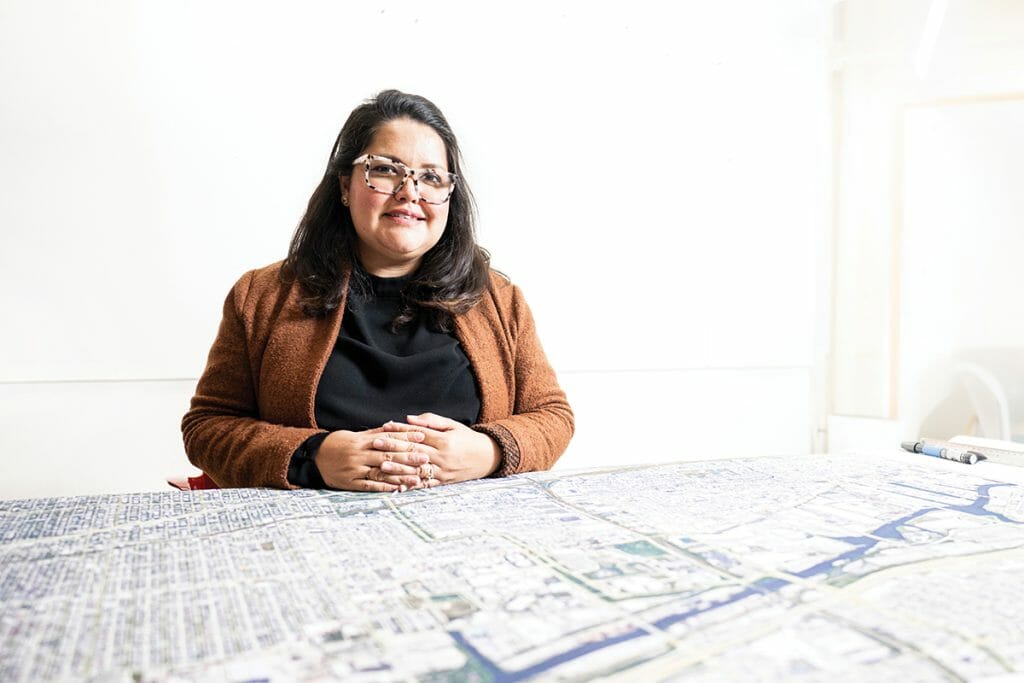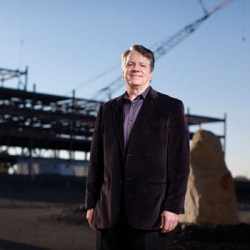“Cities Are Long Overdue for an Upgrade”
UW professor Edna Ely-Ledesma draws up a blueprint for the future.
Nothing about the future is certain, but if the otherworldly settings of science fiction are any indication, we seem to have a clear concept of our future cities: sleek finishes, luminous thoroughfares, and architectural resistance to sharp corners and defined edges.
When teaching tomorrow’s urban planners and architects, Edna Ely-Ledesma is less concerned with ethereal aesthetics than she is with how these cities will protect and provide for their ever-changing populations. Ely-Ledesma is an assistant professor in the UW Department of Planning and Landscape Architecture and the director of the Kaufman Lab for the Study and Design of Food Systems and Marketplaces.
Her work considers cities both as collections of structures governed by policy and zoning and as dynamic, evolving environments. Our cities are long overdue for an upgrade, Ely-Ledesma says, and the choices we make about their future can have global implications.
The pandemic revealed new ways to repurpose city spaces. How can we incorporate this into urban design?
Thinking about adaptability is the most sustainable thing we can do. I preach to my students about how we need to be thinking differently about parking. So much of our cities is constrained by parking standards, and a lot of what we’re living with today is building stock that was built 50 to 100 years ago. What if I tell my students, “You should be building something that you have no idea what it might be in 50 or 100 years”? A parking deck could be a parking deck today, but maybe in 50 years that parking deck could be retrofitted to be office space. The other thing to think about is the environmental impact of demolishing a building. We need to be smarter about thinking about, once we build something on this planet, how do we live with it?
What is “sustainability” in the context of cities?
The important distinction between thinking about sustainability as it was first framed in the 1990s — “let’s just put some solar panels and a nice park in” — and what we’re seeing now is that we are living in a tortured environmental crisis. These environmental impacts that come with a natural disaster are now more frequent, and the most environmentally vulnerable areas of our cities are where we have put communities of color — the areas underlined with racial segregation and racist planning strategies.
We should be building our cities with infrastructure that has the capacity to absorb an extreme flooding event with rainwater harvesting and bioswales [stormwater runoff channels]. We should think about planting more trees with the idea that our own ground could absorb the shock and tension of something like Hurricane Harvey. That’s where sustainability needs to be: managing the crises that will impact the most vulnerable communities.
What is the future of our cities as they stand today?
We are basically going to keep having to patch up our cities, crisis after crisis, wildfire after wildfire, hurricane after hurricane, and we can’t afford to do that. In addition to that, we’re living in a society with aging infrastructure. Our rail systems, our highways, our roads, our housing stock all need to be upgraded. It’s really about waking up and realizing that a lot of change has to happen, but if that change is driven by greed and economics, then inequality will be perpetuated, and I hope that’s not the future of our cities. We need to be thinking about that change being equitable and supportive of all communities.
You’ve talked about a “smart, green, and just 21st-century city.” What does this look like?
It’s the idea that we should be thinking strategically about flexibility in how we build our homes, how we design our streets, how we plan for our cities. That’s what being smart is: thinking more holistically and flexibly. Green is this notion of how we can be sustainable in a way that is equitable. Being a just city allows for opportunities for a business to thrive, whether it’s Google bringing in big-tech money or it’s your grandma trying to keep her bakery going that she’s had in the corner shop for 20 years. It’s the fact that small businesses should have the same kind of access to opportunities as the big players.
What can we realistically hope for in a futuristic city?
Smart mobility is an important component of a future city. We need to be thinking about transportation in a more equitable way. The future of cities is really being more efficient in general.
I would also hope that we are moving away from this hyper-polarization. Part of the reason we are so polarized is because we have stopped talking to one another. We stopped listening to our neighbors. We stopped having conversations. We stopped going to the grocery store. We get everything delivered at home. Technology is great because it can save us time, but we stopped doing the things that I think make our cities great. Being exposed to other people’s ideas is fundamentally why and how we can coexist, so I hope that the future of cities is one that brings us back to socializing and connecting on a human level.
Futurists think technology is our savior. I don’t think it is. It’s a utility that helps us be more efficient. Let’s use technology to deal with energy and transit and movement of goods and services, but when it comes to our identities and how we’re going to survive as a society, we need to put our phones down.
Published in the Spring 2023 issue




Comments
Julie Johnson March 7, 2023
One major compenent of green planning is to place essential services close to residential buildings, so that people can walk or ride a bike. HOWEVER, it is important to consider the elderly and people with disabilities, who may not be able to walk even a short distance. They still need motors, although electric would be cleaner than gas. They also need a place to park.